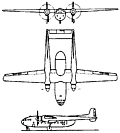|
| Designed as a military transport for service with the French air force, the Nord
2500 Noratlas prototype (F-WFKL)
was flown for the first time on 10 September 1949. Of similar twin-boom configuration to the Fairchild C-82 and C-119
Flying Boxcar, the prototype was
powered by two 1212kW SNECMA-built Gnome-Rhone 14R radial
engines. This was followed by two N 2501 prototypes which introduced the
powerplant intended for production aircraft, comprising two 1521kW SNECMA-built Bristol Hercules 739
radial engines, and the first of these (F-
WFRG) was flown on 28 November
1950. Satisfactory testing led to the initiation of production, and the Noratlas
became standard equipment in the air
forces of France, West Germany and
Israel, providing valuable long-term service. Operated normally by a crew of
four or five, the Noratlas has the capacity
for 7.5 tons of cargo, or can
accommodate 45 troops (or passengers
in civil use), 36 fully-equipped paratroopers, or 18 stretchers and medical attendants when used for casualty evacuation. The German Luftwaffe received a
total of 186 of these transports, 25 built
by Nord and the balance produced under
licence in Germany by the Flugzeugbau
Nord. When production ended in
October 1961, French and German
sources had built a total of 425 Noratlas
aircraft in several versions, and the type remained in
service until the late 1980s.

| MODEL | Nord 2501 |
| CREW | 4-5 |
| PASSENGERS | 45 |
| ENGINE | 2 x SNECMA Hercules, 1521kW |
| WEIGHTS |
| Take-off weight | 21000 kg | 46297 lb |
| Empty weight | 13075 kg | 28826 lb |
| DIMENSIONS |
| Wingspan | 32.5 m | 107 ft 8 in |
| Length | 21.95 m | 72 ft 0 in |
| Height | 6.0 m | 20 ft 8 in |
| Wing area | 101.2 m2 | 1089.31 sq ft |
| PERFORMANCE |
| Max. speed | 440 km/h | 273 mph |
| Ceiling | 7500 m | 24600 ft |
| Range | 3000 km | 1864 miles |
 | A three-view drawing (592 x 654) |
| Holger Schmidt-Lutz, e-mail, 13.02.2015 16:23 As a former pilot on Transall C-160 I've written a novel about the humanitarian efforts of the LUFTWAFFE since 1960, I'd like to attach an overview of participating aircraft, which lists the technical datas and a three-view drawing. On behalf of ND 2501 I was looking unsuccessful in several books for one; searching the internet,the best one I've found is yours on this site. Now I kindly request the permission to use this drawing for the appendix of the novel. If you could license this, give a short notice please: mailto "holger@lutz-utting.de" reply | | Bob Kusterer, e-mail, 07.02.2014 18:59 Why isn't the Noralfa listed. That was a wonderful plane. During WW2, ME 108s were built in France. After the war, Nord modified the 108 substituting a Renault engine for the Argus and converting to tri-gear. reply | | JP, e-mail, 23.03.2012 20:23 I always thought that the NordAtlas was the Nord 2501 (not 2500) reply | | beifang, 20.06.2011 06:02 nord 2500-how much internal fuel it can take and where the fuel tanks are located thanks mikel reply | |
| | Ian Paterson, e-mail, 13.01.2011 19:32 Flew in this on an exchange visit to Creil near Paris (from RAF Leuchars). Can remember it being noisy but good for a piston engine transport. It was just before France left NATO. Creil had Mirage IV there, the Force de Frappe. reply | | Arnaldo Simões, e-mail, 02.10.2010 12:21 Good morning, gentlemen.
This aircraft, wich I flow for several years, was also used by Portuguese Air Force.
Let me say also that this aircraft made a direct flight of 14h00, between Bissau and Luanda, in the day 13SEP1975. I can prove it by my flight registration book, as well of the other crewmembers involved.
I think that this is a record for such an aircraft.
Simões, Arnaldo Captn PoAF, retired reply | | Yeguawian, e-mail, 07.06.2008 15:45 I flew and jump from this transport in Djibouti until 1982 reply | | mikel, e-mail, 07.05.2008 19:20 nord 2500-how much internal fuel it can take and where the fuel tanks are located thanks mikel reply |
|
Do you have any comments?
|
| 
COMPANY
PROFILE
All the World's Rotorcraft
|








